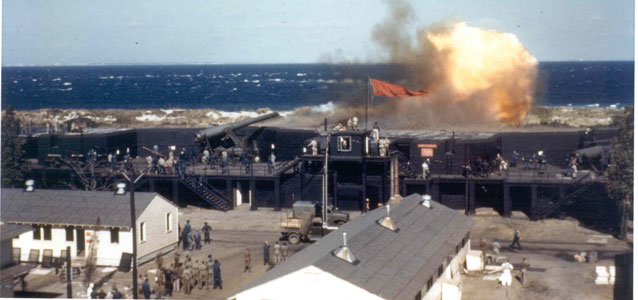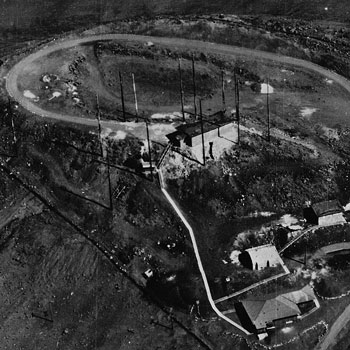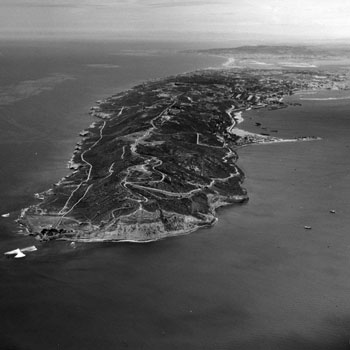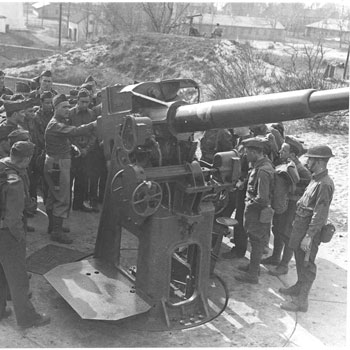As enemy submarines and U-boats crested the surface close to American shores, sites once preserved for their historic significance were called into action. Positioned on hilltops, harbors, shorelines, distant islands and atolls, National Park Service sites linked together a net of forts, radar and radio stations during World War II.

National Park Service
In addition to a barage of requests by the military for training and recreation camps within interior national parks, the military peppered National Park Service (NPS) managers with multiple requests for coastal sites. Their goal was to installing protective apparatus including aircraft detection systems such as radar, radio communications, searchlight batteries and gun batteries.
Though the NPS was only 25 years old at the outbreak of World War II, the young agency negotiated balancing its role in contributing to the war effort with its own mission to protect America's most precious places for future generations.
Aircraft Warning Stations
At the start of World War II, airplanes were laregly short range weapons, fighting each other rather than targets on the ground. The development of the bomber changed everything. To not detract from more pressing military duties, civilian-run Aircraft Warning Stations were erected. At coastal sites around the country, some NPS exmployees took over aircraft obersvation duties on regular shifts. Civilians learned to listen and visually spot aircraft and to distinguish between them. Sightings were logged and reported to military personnel.
Aircraft Warning Stations were erected at Acadia National Parks and the Statue of Liberty on the Atlantic and Denali, Mt. Rainier, Lassen, Yosemite, Channel Islands, and Joshua Tree National Parks on the Pacific Coast.
Olympic National Park hosted multiple AWSs. The Coast Guard used Ruby Beach Resort, Becker’s Ocean Resort, Rialto Beach Resort and Lake Ozette Resort. The US Army used Washburn Resort. Mora Park housed employees engaged in war work.
At Kill Devil Hill in Wright Brothers National Memorial, the military installed an ‘ultra high frequency monitoring system' at the top of the monument presumably to monitor and locate enemy submarines patrolling the shipping lanes off shore.
Radio and Radio

National Park Service
In addition to spotting aircraft, coastal areas in national parks were ideal spots for the erection of radio and radar stations.
Acadia National Park. The Navy operated a radio station on Big Moose Island during World War II and into the Cold War. During that period additional buildings were constructed on the site to serve the U.S. Navy. Apartment housing was constructed to house military personnel. By the end of World War II, the U.S. Naval Radio Station, Winter Harbor, Maine, included ten buildings on Big Moose Island and an operation that was apparently expanding. Maps of Big Moose Island during that period depicted the buildings on site, as well as the construction of additional antenna arrays on the island.
Channel Islands National Park.
Both an Aircraft Warning Station and Radar station were established on Santa Rosa Island in what is now Channel Islands National Park. In 1943 to set up an early warning radar facility on the south side of the island. The Army Corps of Engineers built a radar system at a location now called Signal Hill and a camp about three miles away. The site was closed as the war ended and the buildings and materials were left to be used by the ranch.
Dry Tortugas National Park. The historic Fort Jefferson was also used as a radar station and a landing area for sea planes.
Haleakala National Park. From 1941-1948, the summit of Haleakalā (Red Hill) was the site of various installations; the first, a fixed radar station associated with the Aircraft Warning Service system. The radar station was not always considered successful and was operated only intermittently until March 1943 when the facility was abandoned except for a few guards to protect the property. The 360 degree clear line allowed radar signals to bounce back to the station from 360 degrees, causing a confusing "echo." Later radar sites were located so as to minimize the echo by placing them against a solid background.
As with many military use sites in parks during the war, park staff protested that he heavy construction at Red Hill was damaging the site. The peak had already been leveled off, thereby reducing Maui's highest elevation by several feet. A new brick power house and another large brick building were going up although the work stopped for a time midway when the supply of bricks ran out. Most distressing of all were the 90-foot radio poles with red lights atop, soon dubbed the "Haleakala National Forest." As battles in the Pacific raged, this was of course dismissed as "essential to the successful prosecution of the war in this area."
The Army also built a base camp for personnel stationed at the Summit on a six-acre site near Pu'u Nianiau. The Puʻu Nianiau base camp was turned over to the NPS in 1946. Red Hill was returned to the NPS in 1948; however, the dilapidated military buildings and antennae were not removed until 1961.
Forts: Ready to Fire

National Park Service

National Park Service
Gateway National Recreation Area. Defending New York Harbor for generations, the defense installations in Sandy Hook,
- Fort Hancock. Built in 1895, Historic Fort Hancock is located on the northern end of the six mile long peninsula of Sandy Hook, New Jersey. Fort Hancock’s defenses included weapons multiple guns that could be targeted at approaching ships up to 20 miles away. During World War II, its two Model 1900 6-inch Barbette guns were mounted. Today, they are the only surviving guns of Fort Hancock’s gun batteries. By World War II, Fort Hancock had several anti-aircraft gun batteries located at or near its older gun batteries. Their guns were protected from aerial bombing by the addition of thick concrete walls and roofs called casemates. Its vast tunnel system, originally designed for easy transport of weapons and men, was converted into a secret command post during the war. Fort Hancock also played a critical role in developing and using radar and had a detachment of the Women's Army Corps.
- Floyd Bennet Field. Dedicated in 1931, Floyd Bennett Field was New Yorks first municipal airport. In 1941, Floyd Bennett Field was sold to the United States Navy and became Naval Air Station-New York. During World War II, Floyd Bennett Field was the busiest naval air station in the United States. The field was used for training and antisubmarine patrol flights. It was also the home of the Naval Air Ferry Command which was responsible for the acceptance, commissioning, and ferrying of naval aircraft from the factories to the fleet.
Last updated: December 2, 2015
